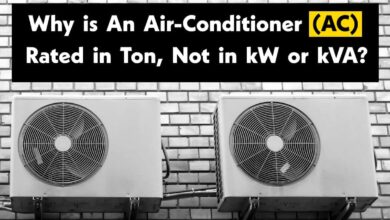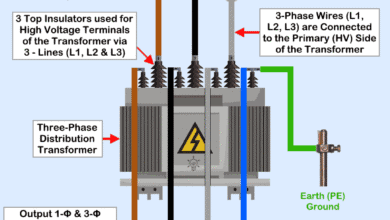Is it Possible to Operate a 50Hz Transformer on 5Hz or 500Hz Frequency?
What Happens if a 50Hz Transformer is Connected to 5Hz or 500Hz Supply Frequency?
What would happen if a power transformer designed for operation on 50Hz frequency were connected to a 5 Hz frequency or 500Hz source of the same voltage?
Power transformer is made to operate on specific frequency, usually 50Hz or 60Hz. Let’s see what happens if a 60Hz or 50Hz transformer is connected to the 5Hz and 500Hz frequency then.
Transformer Rating & Parameters
Suppose, a transformer rating as follow where the rated frequency is 50Hz.
- V = Voltage = 11kV
- R = Resistance = 100Ω
- L = Inductance = 0.3 Henry
- f = Frequency = 5Hz, 50Hz & 500Hz
Related Post: Which Transformer is More Efficient When Operates on 50Hz or 60Hz?
50 Hz Transformer Operated on rated 50Hz
We can find the transformer primary current by I = V/Z (Ohm’s Law i.e. I = V/R) where the Z is the impedance (resistance of AC circuits) which further depends on inductive reactance (XL).
To calculate the circuit impedance, we will have to find the inductive reactance first.
Inductive Reactance = XL = 2πfL = 2 x 3.1415 x 50 x 0.3
XL = 94.2Ω
and
Impedance Z = √ (R2+XL2)
Z = √ (1002+94.2 2)
Z = 137.4 Ω
The current in the transformer primary
I = 11kV / 137.4 Ω
I = 80 A
Now, Power of the circuit
P = V x I x Cos θ …. (i.e. P ∝ I in this case)
Current is directly proportional to the current.
Power factor = Cos θ = R/Z
Cos θ = 100 Ω / 137.4 Ω
Cos θ = 0.73
P = V x I x Cos θ
P = 11kV x 80A x 0.73
P = 642.4kW
I.e. The rated Power is appropriate when transformer is operated on the rated frequency of 50Hz.
50 Hz Transformer Operated on 5Hz
If the frequency is too low, primary will have insufficient reactance and too much primary current will flow, producing considerable copper losses (P = I2R). The transformer may start to smoke and burn with blast leading to dangerous fire.
Transformer with same rating is connected to the 5Hz supply source. We will do the same calculation to find the current in case of lower frequency than rated frequency of 50Hz.
Inductive Reactance = XL = 2πfL = 2 x 3.1415 x 5 x 0.3
XL = 9.42 Ω
and
Impedance Z = √ (R2+XL2)
Z = √ (1002+9.422)
Z = 100.44 Ω
The current in the transformer primary
I = 11kV / 100.44 Ω
I = 109.52 A
Power factor = Cos θ = R/Z
Cos θ = 100 Ω / 100.44 Ω
Cos θ = 0.9
P = V x I x Cos θ
P = 11kV x 109.52 x 0.9
P = 1084kW
The power is much more than the rated power of the transformer due to high current, high magnetizing current and more power flux. This will cause insulation losses and transformer may stat to smoke due to low inductive reactance to oppose the flow of large current.
Related Post: Why Transformer Does not Work on DC Supply instead of AC?
50 Hz Transformer Operated on 500Hz
If the frequency is too much high as compared to the rated frequency, the inductive reactance of the primary will prevent the primary from drawing sufficient power. The hysteresis losses and eddy current losses will be excessive.
The same transformer is connected to the 500Hz frequency supply. Let’s do the same calculation as above to find the current in case of higher frequency.
Inductive Reactance = XL = 2πfL = 2 x 3.1415 x 500 x 0.3
XL = 942.4 Ω
and
Impedance Z = √ (R2+XL2)
Z = √ (1002+942.42)
Z = 947.7 Ω
The current in the transformer primary
I = 11kV / 947.7 Ω
I = 11.6 A
Power factor = Cos θ = R/Z
Cos θ = 100 Ω / 947.7 Ω
Cos θ = 0.1
P = V x I x Cos θ
P = 11kV x 11.6A x 0.1
P = 12.76kW
The amount of transferred power is too much low as compared to the rated power in case of higher frequency of 500Hz.
As mentioned above, when current is reduced through high inductive reactance (due to high frequency where XL = 2πfL), power will be reduced because current is directly proportional to the power. In addition, eddy current and hysteresis losses will be excessive.
The reason behind this story is that:
I = V/Z
Where
Z = √ (R2+XL2)
But
XL = 2πfL i.e. XL ∝ f
i.e.
XL ∝ 1/I
And P ∝ I
and
ΦMax ∝ V and I. … (ΦMax = – VM / ωNP)
Related Posts:
- Why Current Increases When Capacitance Increases or Capacitive Reactance Decreases?
- Why Current Decreases When Inductance or Inductive Reactance Increases?
- In a Capacitive Circuit, Why the Current Increases When Frequency Increases?
- In an Inductive Circuit, Why the Current Increases When Frequency Decreases?
- Why Power Factor Decreases When Inductance or Inductive Reactance Increases?
- Why Power Factor Decreases When Capacitive Reactance Increases or Capacitance Decreases?








No.
Is is not feasible to operate it on low or at high frequency if you do this, the transformer will damage because at higher frequency the losses will become high and the vibration become high which can damage insulation and the mechanical structure and at lower frequency the output will be highly deviated from the rated and heating also takes place which can damage the insulation
Yes it is possible to operate by using a step down transformer
I want to add another point to the already well explained answer…since cos@= R/Z so as Z increases in the case of f=500, current reduces as you said….and also the power factor reduces while voltage is at 230V.
As the transformer size(area)remains thesame and”f” becomes 10 times…so from the equation pi(flux)=B*Awhere B is proportional to V/fAS V/F ratio is reduced the working flux gets reduced so the power transfer capability and secondary voltage will be reduced.As the Flux is reduced the MAGNATISING CURRENT which is required to produce the flux also reduced so the power factor improves a littlebit.Eddylossis proportional to voltagesquare so it remains constantbut the hysterisis loss will increase as they were proportional to “f”.so its effects can be summerised as follows:1.Rating will be reduced(as working flux is reduced)2.Regulation will be increased(as reactance drop increases with “f”)3.power factor will be improved(as magnetising current reduces)4.efficiancy is slightly reduced(as only Whare increased)5.Hissing soung becomes predominant.6.Strayload loss will gets increased.
how to test a 150 Hz designed transformer at a 50 Hz power supply
Transformer – 4 KVA 3 Phase – Delta / Star
415 / 50 volt .
Is it possible to Operate a 50Hz 3 phase motors on 60Hz frequency Supply?
Its very nice reply with simple language and expiation. thank you very much for helping us.
Thanks for this very interesting post. I learned a lot on this.
Please inform me,how i can develop programming about zero level.
some advice, reference items.
Yes it is possible.
Use this formula,(R/Z)
No. The frequency is constant value.
How do you convert the percentage impedance of a transformer to resistance and inductance